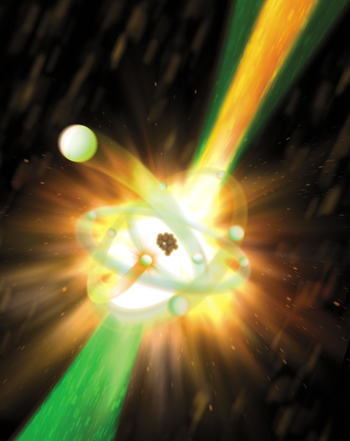Scientists create femtosecond atomic X-ray laser
January 27, 2012

A powerful X-ray laser pulse from SLAC National Accelerator Laboratory's Linac Coherent Light Source comes up from the lower-left corner (green) and hits a neon atom (center), which emit more X-rays, creating a domino effect that amplifies the laser light 200 million times. (Credit: Gregory M. Stewart/SLACj/Nature)
Lawrence Livermore Lab (LLNL) scientists and international collaborators have created the shortest, purest X-ray laser pulses ever achieved, fulfilling a 45-year-old prediction and ultimately opening the door to new medicines, devices and materials.
The researchers aimed radiation from the Linac Coherent Light Source (LCLS), located at the Stanford Linear Accelerator Center (SLAC), at a cell containingneon gas, setting off an avalanche of femtosecond-duration
X-ray emissions to create a new “atomic X-ray laser” in the kiloelectronvolt energy regime.
“X-rays give us a penetrating view into the world of atoms and molecules,” said physicist Nina Rohringer, a former LLNL postdoc, now a group leader at Max Planck Society’s Advanced Study Group. She collaborated with researchers from SLAC, LLNL and Colorado State University.
The new laser fulfills a 1967 prediction, which proposed that X-ray lasers could be made by first removing inner electrons from atoms and then inducing electrons to fall from higher to lower energy levels, releasing a single color of light in the process. But until 2009, when LCLS turned on, no X-ray sources were powerful enough to create this type of laser.
To make the atomic X-ray laser, LCLS’s powerful X-ray pulses — each a billion times brighter than any available before — knocked electrons out of the inner shells of many of the neon atoms. When other electrons fell in to fill the holes, about one in 50 atoms responded by emitting a “hard X-ray,” which has a very short wavelength (1.46 nanometers). Those X-rays then stimulated neighboring neon atoms to emit more X-rays, creating a domino effect that amplified the laser light 200 million times.
It may be useful for high-resolution spectroscopy and nonlinear X-ray studies.
In the future, Rohringer says she will try to create even shorter-pulse, higher-energy atomic X-ray lasers using oxygen, nitrogen or sulfur gases.
Ref.: Nina Rohringer, et al., Atomic inner-shell X-ray laser at 1.46 nanometres pumped by an X-ray free-electron laser, Nature, 2012; 481 (7382): 488 [DOI:10.1038/nature10721]